Class - 9 Science (Chemistry) Chapter - 2 Is Matter Around Us Pure ? Notes, NCERT Solutions & Frequently Asked Questions
Class - 9
Science (Chemistry)
Chapter - 2
Is Matter Around Us Pure ?
Notes, NCERT Solutions & Frequently Asked Questions
-- Notes --
What is a substance?
- Anything that cannot be broken into further particles by applying any physical processes is called a Substance.
- Matter can be classified into two types of substances – Pure substances and Mixtures
What is a pure substance?
A substance that consists of only one type of particle is called a Pure Substance. For Example, Diamond, Salt, Sulphur, Tin.
What is a mixture?
- When we combine different substances into each other a mixture is formed. For Example, Lemonade is a mixture of three substances, Lemon Juice, Sugar and Water.
Types of Mixtures
There are two categories of mixtures: Homogeneous Mixtures and Heterogeneous Mixtures

Homogenous Mixtures
- When we add sugar, water and lemon juice together they all uniformly mix with each other. Now it is not possible to separate these substances from the mixture. Such mixtures in which the components mix with each other uniformly are called Homogeneous Mixtures.
- The ratio of compositions of homogeneous mixtures can be different. For Example, one may add two spoons of sugar in lemonade while someone else may add only one spoon of sugar in their lemonade. Still, lemonade is a homogeneous mixture.
Heterogeneous Mixtures
- The components in a heterogeneous mixture do not completely dissolve in each other and we can separate them by physical means. In other words, the composition of such mixtures is not uniform.
- For Example, If we mix sand in water the sand settles down in water after some time and we can separate it by filtration.
Differences between homogeneous and heterogeneous mixtures –
Homogenous Mixtures | Heterogeneous Mixtures |
They have a uniform composition throughout | They have a non-uniform composition |
We cannot separate the components of the mixture through physical processes | We can separate the components through physical processes |
Components cannot be seen through naked eyes | Components can easily be seen through naked eyes |
The mixture is in single-phase throughout | The substances can be of two different phases and we may see separate layers of the substances |
Example: A mixture of water and milk | Example: A mixture of oil in water |
What is a solution?

A solution is nothing but a uniform mixture of two or more substances. Homogenous Mixtures are solutions.
Solution of -
- Liquid into a liquid: Water and Ink
- Solid into solid: Alloys
- Gas into gas: Air
- Solid into a liquid: Sugar and Water
- Solid into gas: Hydrogen and Metals
- Liquid into gas: Carbon Dioxide and Water
What is an alloy?
An alloy is a mixture of different metals or nonmetals and metals that cannot be separated from each other using physical methods.
Brass – Copper with up to 50% zinc
Bronze – Copper with up to 12% tin

Solution is consists of two types of substances, a solute and a solvent.
Solution = Solute + Solvent
Solvent – The substance in which another substance is mixed is called the Solvent. For Example, Water is a solvent in which we can mix different substances such as salt or sugar.
Solute – The substance that is added to the solvent to form a solution is called a Solute. For Example, Salt, when mixed in water, acts as a solute for the mixture.
Properties of a Solution:-
- A solution is a homogeneous mixture.
- We cannot see the particles of a solution through naked eyes as they are as small as 1 nanometer in diameter.
- The path of light is not visible through the solution. The particles of a solution do not scatter light through them as they are extremely small.
- We cannot separate the particles of a solution by methods of filtration.
What is a stable solution?
A stable solution is a solution in which particles do not settle down if we leave the solution undisturbed for some time. This is because the particles of a stable solution are homogeneously spread.
Different Types of Solutions
- Dilute – A solution in which the concentration of the solute is much less than that of the solvent. For Example, If we mix 1gm of salt in 500 ml of water, the salt solution thus obtained will be diluted. If we keep on adding the solute in a solution there comes a point when no more solute dissolves in the solution. This is called the Saturation Point of a Solution.
- Unsaturated Solution – A solution, in which we can add more solute as it has not achieved its saturation level yet, is called an Unsaturated Solution. A dilute solution can be called an Unsaturated Solution.
- Concentrated Solution – A solution with a large amount of solvent is called a Concentrated Solution.
- Saturated Solution – A solution in which no more solute can be added since it has already dissolved the maximum amount of solute it can is called a Saturated Solution.
What is concentration?
Concentration refers to the amount of a substance per defined space or can be defined as the ratio of solute in a solution to either solvent or total solution.
- Percent by Mass = (Mass of solute / Mass of solution) X 100
- Percent by Volume = (Volume of solute / volume of solution) X 100
- Molarity (M) = number of moles of solute / Volume of Solution in litres
Where, Moles of solute = Given mass/molar mass
- Molality (m) = Moles of solute / weight of solvent in kg
- Normality (N) = Number of mole equivalents / volume of solution in litres
= Mass of solute / (equivalent mass * volume of solution in Litres)
What is a suspension?
A suspension is formed when two or more substances are mixed in a non-uniform manner. Heterogeneous mixtures are suspensions. The solute does not mix with the solvent and can be viewed through naked eyes.
Properties of Suspensions:-
- A suspension is a heterogeneous mixture.
- We can see the particles of suspensions through naked eyes.
- We can see the path of light through the particles of a suspension.
- The particles of suspension tend to settle down when left undisturbed. Then, they can be separated using filtration.
What are colloids or colloidal solutions?
A colloidal solution or a colloid is a uniform solution of two or more substances. The particles are relatively very small and the solution appears as a homogeneous mixture but it is not.
Properties of colloids:-
- Colloids are heterogeneous in nature.
- The particles of a colloid cannot be seen through naked eyes.
- The particles scatter a beam of light passed through a colloid and produce the Tyndall effect.
- Colloids are stable in nature. The particles of colloids do not settle down if left uninterrupted.
- We cannot separate the particles of a colloid through filtration. We use a method called Centrifugation to separate the particles of a colloid.
What is the Tyndall Effect?
When a beam of light is passed through a colloid the particles of the colloid scatter the beam of light and we can see the path of light in the solution. For Example, when a ray of light enters a dark room it is scattered by the dust particles present in the air and we can see the path of light clearly.
Classification of Colloids
Dispersed Phase – The dispersed particles or the solute-like components in a colloid
Dispersing Medium – The substance in which these solute-like particles are added
Based on the state of the dispersing medium colloids are classified as:
Types of Colloids
Example | Dispersing Medium | Dispersed Substance | Colloid Type |
Fog, Aerosol sprays | Gas | Liquid | Aerosol |
Smoke, Airborne bacteria | Gas | Liquid | Aerosol |
Whipped cream, Soapsuds | Liquid | Gas | Foam |
Milk, Mayonnaise | Liquid | Liquid | Emulsion |
Paints, Clays, Gelatin | Liquid | Solid | Sol |
Marshmallow, Styrofoam | Solid | Gas | Solid foam |
Butter, cheese | Solid | Liquid | Solid emulsion |
Ruby glass | Solid | Solid | Solid sol |
How to separate components of a mixture?
We can separate the heterogeneous mixtures into their constituents by means of physical methods like
- Filtration
- Hand-picking
- Sieving
The components of a mixture can be separated from each other using several other techniques like
- Evaporation
- Centrifugation
- Sublimation
- Chromatography
- Distillation
- Evaporation – For separating a mixture of a non-volatile and a volatile substance

- Applications:
- Separating coloured component from the ink
- Salt from water
- Sugar from Water
- Method:
- Mix some ink into water and heat it. After some time the water will evaporate leaving behind the coloured substance.
- Centrifugation – Separating dense particles from lighter particles
- Applications:
- Separating milk from cream
- Separating butter from cream
- Squeezing out water from wet clothes
- Method:
- Milk is put in a centrifuging machine or milk churner and the cream thus separates from milk.
- Using a Separating funnel – To separate two immiscible liquids

- Applications:
- Oil from water
- Iron and iron ore
- Method:
- The immiscible liquids are allowed to settle in the funnel. They soon form separate layers due to varying densities. The first liquid is allowed to flow out of the funnel and as soon as it is completely poured out, the stopcock is closed thereby separating the two liquids from each other.
- Sublimation – To separate a sublimable component from a non-sublimable component

- Applications:
- Ammonium chloride/camphor/naphthalene and salt
- Method:
- Heat the mixture in an inverted funnel so that the sublimable component sublimes in the air and settles over the walls of the funnel and the non-sublimable component, on the other hand, is left behind.
- Chromatography – To separate solutes that can dissolve in the same solvent

- Applications:
- Separating colour components of a dye
- Drugs from blood
- Method:
- Take a filter paper or a blotting paper and place a drop of ink at the rear end. Dip the end in water. Since the ink is a mixture of two or more colours, the component of ink which is soluble in water mixes into it and then separates quickly from the other components that are less soluble in water.
- Distillation – To separate miscible liquids (the boiling points of the liquids must be sufficiently different)

- Applications:
- Acetone and water
- Method:
- The mixture is heated in a distillation apparatus. The one substance with a lower boiling point evaporates first, condenses and gets separated from the one with a higher boiling point.
- Simple Distillation – when the miscible liquids have a satisfactory difference in their boiling points
- Fractional Distillation – when the difference between the boiling points of the liquids is less than 25 K
Separating different Gases from the Air
Method – Fractional Distillation
- Compress and cool the air by increasing the temperature and decreasing the pressure. The air turns to liquid air.
- Liquid air is warmed up slowly in a fractional distillation apparatus
- The several components of air get separated and are collected at various heights on the basis of their boiling points
Purifying Solids
Method used – Crystallisation
In the crystallisation method, we can obtain a pure solid in the form of crystals from its solution

- Applications:
- Salt from seawater
- Purification of copper sulphate
- Method:
- The impurities of a substance are filtered out.
- Water is evaporated to obtain a saturated solution.
- The solution is covered with filter paper and left as it is.
- After some time, the crystals of pure solid are formed.
- Is evaporation better than crystallisation?
Simple evaporation is not better than crystallisation because
- Some solid substances decompose because of excess heat. For Example, Sugar gets charred on extra heating.
- If after filtration some impurities remain in the solution they can contaminate the solid and therefore we would not obtain a pure substance.
Physical Change and Chemical Change
Physical Property of a Substance:
Properties of a substance such as rigidity, colour, fluidity, boiling point, melting point, density and hardness which we can observe are called Physical Properties.
Physical Change:
When the physical properties of a substance change it is known as a Physical Change. When we convert a substance from one state to another, such as a solid into a liquid or vice-versa, it is also a physical change as only the physical nature of the substance changes without affecting its chemical nature.
For Example, Change of ice into water. The chemical properties of water remain the same.
Chemical Property of a Substance:
The chemical nature of a substance is known as its Chemical Property such as its odour or its chemical composition.
Chemical Change:
When the chemical properties or chemical composition of a substance gets altered it is called a chemical change. It is also called a Chemical Reaction.
For Example, Burning paper
Types of Pure Substances
Pure substances are classified as elements and compounds
Elements
An element is the simplest form of matter. Elements cannot be broken down into further elements by chemical reactions. Elements are further characterised as Metals, Nonmetals and Metalloids
Metals – Silver, Mercury, Copper, Gold
- Metals are lustrous (shiny)
- Metals conduct heat and electricity
- Metals have a silver-grey or gold-yellow colour
- We can hammer metals and form thin sheets (Malleability)
- We can convert metals into wires (Ductility)
- Metals always produce a ringing sound if they are hit (Sonorous)
Non-Metals – Carbon, Iodine, Chlorine, Oxygen, Hydrogen
- Non-Metals do not conduct heat and electricity
- Non-Metals are not sonorous, lustrous or ductile
- Non-Metals have varied colours
Metalloids – Silicon, Germanium
They show some properties of metals and some of the non-metals.
Quick Facts –
- There are 118 elements known to us
- 94 elements out of them occur naturally
- Rest, 24 are man-made elements
- Most of the elements are solid in nature
- At room temperature, 11 elements exist in the gaseous state
- At room temperature, 2 elements exist in the liquid state – bromine and mercury
- At a temperature slightly higher than room temperature, 2 elements exist in the liquid state – calcium and gallium
- Technetium was the first element to be made artificially.
Compounds
It is a substance that consists of two or more substances. These substances are combined chemically with each other in fixed proportions. The properties of a compound are different from that of its constituents. For Example, Ammonium Sulphate, Sulphur Chloride, Water.
Mixtures vs. Compounds
Mixtures | Compounds |
Properties of a mixture Reflect the properties of the materials it contains. | Different properties from that of the elements that make up the compounds. |
No uniform composition | Definite composition. Definite ratio/formula |
Can be separated by physical means. | Cannot be separated by physical means. |
In-Text Questions (Page 15)
Question 1.- What is meant by a substance?
Answer:- A pure substance consists of a single type of particles.
Question 2.- List the points of differences between homogeneous and heterogeneous mixtures.
Answer:-
In-Text Questions (Page 18)
Question 1.- Differentiate between homogeneous and heterogeneous mixtures with examples.
Answer:-
Question 2.- How are sol, solution and suspension different from each other?
Answer:-
Question 3.- To make a saturated solution, 36 g of sodium chloride is dissolved in 100 g of water at 293 K. Find its concentration at this temperature.
Answer:- Mass of solute (sodium chloride) = 36 g
Mass of solvent (water) = 100 g
Mass of solution = Mass of solute + Mass of solvent
= 36 g + 100 g = 136 g
In-Text Questions (Page 24)
Question 1.- How will you separate a mixture containing kerosene and petrol (difference in their boiling points is more than 25°C), which are miscible with each other?
Answer:- A mixture of kerosene and petrol which are miscible with each other can be separated by distillation.
Method
- Take a mixture in a distillation flask.
- Fit it with a thermometer.
- Arrange the apparatus as shown in the figure.
- Heat the mixture slowly.
- Petrol vapourises first as it has lower boiling point. It condenses in the condenser and is collected from the condenser outlet.
- Kerosene is left behind in the distillation flask.
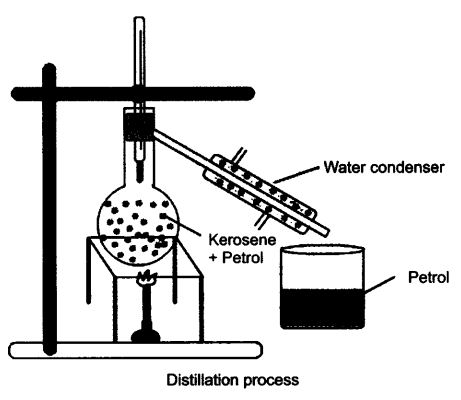
Question 2.- Name the technique to separate
(i) butter from curd,
(ii) salt from sea-water,
(iii) camphor from salt.
Answer:- i) Centrifugation ii) Evaporation iii) Sublimation.
Question 3.- What type of mixtures are separated by the technique of crystallisation?
Answer:- Crystallisation technique is used to purify solid with some impurities in it. Example: Salt from sea-water.
In-Text Questions (Page 24)
Question 1.- Classify the following as chemical or physical changes:
- cutting of trees,
- melting of butter in a pan,
- rusting of almirah,
- boiling of water to form steam,
- passing of electric current, through water and the water breaking down into hydrogen and oxygen gas,
- dissolving common salt in water,
- making a fruit salad with raw fruits and
- burning of paper and wood.
Answer:-
Question 2.- Try segregating the things around you as pure substances or mixtures
Answer:- Pure substances—Water, bread, sugar and gold.
Mixtures—Steel, plastic, paper, talc, milk and air.
NCERT Exercise
Question 1.- Which separation techniques will you apply for the separation of the following?
a) Sodium chloride from its solution in water.
b) Ammonium chloride from a mixture containing sodium chloride and ammonium chloride.
c) Small pieces of metal in the engine oil of a car.
d) Different pigments from an extract of flower petals.
e) Butter from curd.
f) Oil from water.
g) Tea leaves from tea.
h) Iron pins from sand.
i) Wheat grains from husk.
j) Fine mud particles suspended in water.
Answer:- a) Evaporation b) Sublimation c) Filtration d) Chromatography
e) Centrifugation f) Separating funnel g) Filtration h) Magnetic separation
i) Winnowing/ sedimentation j) Decantation and filtration
Question 2.- Write the steps you would use for making tea. Use the words, solution, solvent, solute, dissolve, soluble, insoluble, filtrate and residue.
Answer:- 1. Take a cup of water in a container as solvent and heat it.
2. Add sugar in it which is solute. Heat it till all sugar dissolves.
3. You get a solution of water and sugar.
4. Sugar is soluble in water completely.
5. Add half a tea-spoon of tea-leaves, it is insoluble in water.
6. Boil the content, add milk which is also soluble in water, boil again.
7. Filter the tea with the help of strainer, the tea collected in cup is filtrate and the tea leaves collected on the strainer is residue.
Question 3.- Pragya tested the solubility of three different substances at different temperatures and collected, the data as given below (results are given in the following table, as grams of substance dissolved in 100 grams of water to form a saturated solution).
a) What mass of potassium nitrate would be needed to produce a saturated solution of potassium nitrate in 50 grams of water at 313 K?
b) Pragya makes a saturated solution of potassium chloride in water at 353 K and leaves the solution to coo! at room temperature. What would she observe us the solution cools? Explain.
c) Find the solubility of each salt at 293 K. Which salt has the highest solubility at this temperature?
d) What is the effect of change of temperature on the solubility of a salt?
Answer:-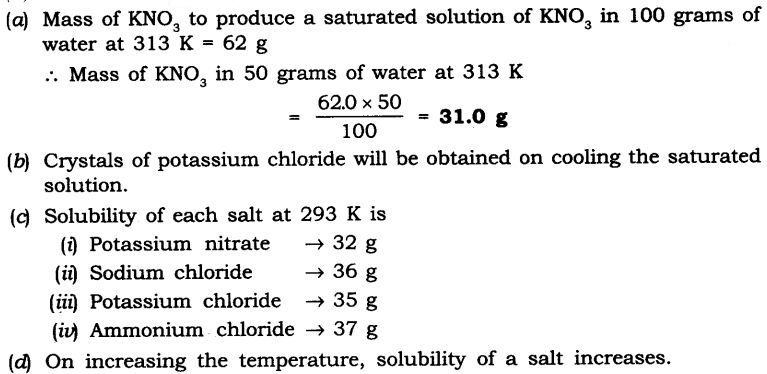
Question 4.- Explain the following giving examples:
a) Saturated solution
b) Pure substance
c) Colloid
d) Suspension
Answer:- a) Saturated solution: In a given solvent when no more solute can dissolve further at a given temperature is called saturated solution.
b) Pure substance: A pure substance consists of a single type of particles. E.g., gold, silver.
c) Colloid: A colloid is a solution in which the size of solute particles are bigger than that of true solution. These particles cannot be seen with our naked eyes, they are stable, e.g., ink, blood.
d) Suspension: It is a heterogeneous mixture in which the solute particles are big enough to settle down, e.g., chalk-water, paints, etc.
Question 5.- Classify each of the following as a homogeneous or heterogeneous mixture: soda water, wood, air. soil, vinegar, filtered tea.
Answer:- Homogeneous: Soda water, vinegar, filtered tea.
Heterogeneous: Wood, air, soil.
Question 6.- How would, you confirm that a colourless liquid given to you is pure water?
Answer:- By finding the boiling point of a given colourless liquid. If the liquid boils at 100°C at atmospheric pressure, then it is pure water. This is because pure substances have fixed melting and boiling point.
Question 7.- Which of the following materials fall in the category of a 'pure substance'?
a) Ice b) Milk c) Iron d) Hydrochloric acid e) Calcium oxide
f) Mercury g) Back h) Wood i) Air.
Answer:- Pure substances are: Ice, iron, hydrochloric acid, calcium oxide and mercury.
Question 8.- Identify the solutions among the following mixtures.
a) Soil b) Sea water c) Air d) Coal e) Soda water.
Answer:- Solutions are: Sea water soda water and air.
Question 9.- Which of the following will show “Tyndall effect”?
a) Salt solution b) Milk c) Copper sulphate solution d) Starch solution.
Answer:- Milk and starch solution.
Question 10.- Classify the following into elements, compounds and mixtures.
a) Sodium b) Soil c) Sugar solution d) Silver e) Calcium carbonate
f) Tin g) Silicon h) Coal i) Air j) Soap k) Methane
l) Carbon dioxide m) Blood
Answer:-
Question 11.- Which of the following are chemical changes?
a) Growth of a plant b) Rusting of iron c) Mixing of iron filings and sand d) Cooking of food e) Digestion of food f) Freezing of water
g) Burning of a candle.
Answer:- Chemical changes are:
a) Growth of a plant b) Rusting of iron c) Cooking of food d) Digestion of food
e) Burning of a candle
--- Previous Years Questions ---
Question 1.- Why is mixture called impure substance?
Answer:- Mixture consists of different components which retain their properties and can be easily separated by physical processes, hence it is called as impure substance.
Question 2.- Give the differences between mixture and compound.
Answer:-
Question 3.- Distinguish between a physical change and chemical change.
Answer:-
Question 4.- State the properties of a solution.
Answer:- Properties of a solution are:
- A solution is a homogeneous mixture.
- Particles of a solution are smaller than 1 nm and cannot be seen by naked eyes.
- Do not scatter beam of light.
- Solute particles cannot be separated from the mixture by the process of filtration and thus, solution is stable.
Question 5.- State the properties of a suspension.
Answer:- Properties of a suspension
- Suspension is a heterogeneous mixture having particle size greater than 100 nm.
- The particles of a suspension can be seen by naked eyes.
- Particles can scatter a beam of light.
- It is unstable.
Question 6.- What is a colloidal solution?
Answer:- It is a heterogeneous solution which appears to be homogeneous, particles size is very small and so cannot be seen with naked eyes but it is stable. E.g., milk and blood.
Question 7.- State the properties of colloidal solution.
Answer:- Properties of colloidal solution.
- It is a heterogeneous mixture having particle size between 1 nm to 100 nm.
- Size of particles is very small, cannot be seen with naked eyes.
- It scatters a beam of light.
- They are stable as the particles do not settle when left undisturbed.
Question 8.- Give the applications of centrifugation.
Answer:- Application of centrifugation are:
- Used in diagnostic laboratories for blood and urine test.
- Used in dairies and home to separate butter from cream.
- Used in a washing machines to squeeze out water from wet clothes.
Question 9.- Give the applications of chromatography.
Answer:- Applications of chromatography are
- To separate colours in a dye.
- To separate pigments from natural colours.
- To separate drugs from blood.
Question 10.- Why is crystallisation better than evaporation?
Answer:- Crystallisation is a process that separates a pure solid in the form of its crystals from a solution. Crystallisation is better than evaporation because during Evaporation
- Some solids decompose or some, like sugar may get charred on heating to dryness.
- Some impurities may remain dissolved in the solution even after filtration which on evaporation contaminates the solid.
Question 11.- How will you separate a mixture of oil and water?
Answer:- To separate a mixture of oil and water, we need a separating funnel as both are immiscible liquids. Pour the mixture in separating funnel and let the funnel stand undisturbed for sometime. So that separate layer of oil and water are formed. Open the stopcock of the separating funnel and pour out the lower layer of water carefully.
Question 12.- A student is given a mixture of naphthalene ball’s powder and common salt. He need to separate this mixture. How will he do this?
Answer:- The properties of both naphthalene and common salt should be known, before we choose the separation technique.
Naphthalene is a sublimate which on heating changes to gaseous state directly. Hence to separate a volatile compound (sublimate) from a non-volatile compound (non-sublimate), the sublimation process is used.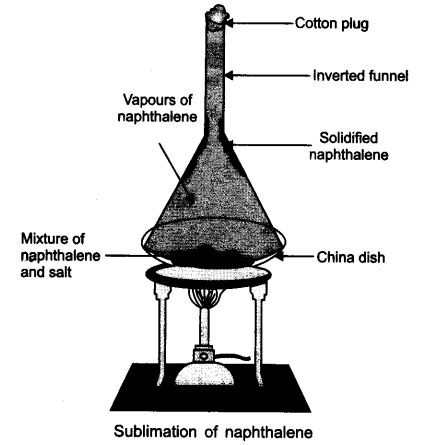
In a China dish the mixture is kept, and is placed on a stand. An inverted funnel is kept over the mixture in China dish with plugged stem. The sublimate on heating gets collected on the funnel and common salt remains in the China dish.
Question 13.- How can we obtain different gases from air?
Answer:- Air is a homogeneous mixture and its components can be separated by fractional distillation.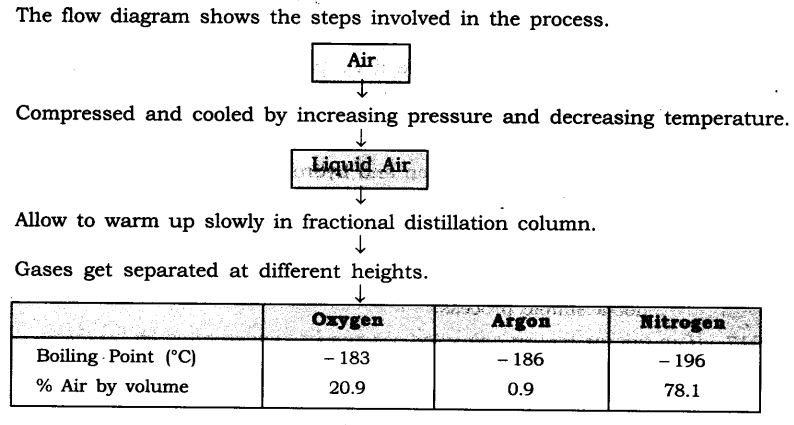
Question 14.- Draw a flow diagram to show the water purification system in water works.
Answer:-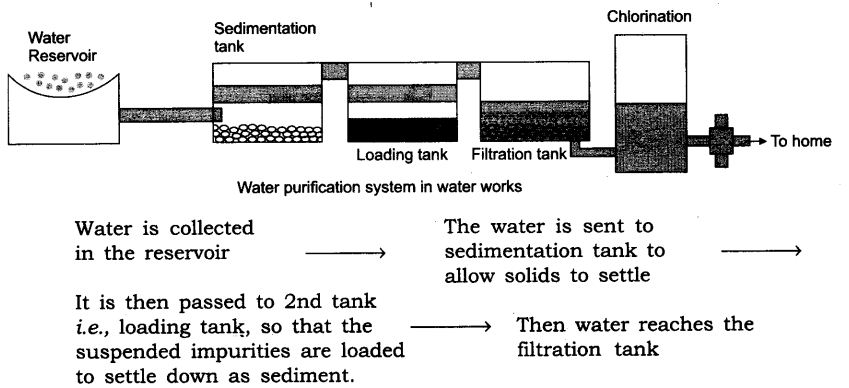
In filtration tank water passes through different layers of sand and gravel as shown in the above figure this is for adsorption of impurities.
The clear water reaches a chlorinated tank where water is mixed with bleaching powder/chlorine to kill bacteria and then supplied to houses.
Question 15.- Why is air considered as a mixture and not compound?
Answer:- Air is considered as a mixture because it exhibits following properties:
- Each component present in air retains its properties.
- Each component can be separated by simple physical processes.
- The components do not have any fixed proportion. All gases are present in different amount. Example, in greener area—more oxygen and water vapour is present; near industrial area—air consists of lot of impurities and smoke suspended in it.
Question 16.- How can you prove that water is a compound?
Answer:- Water is a compound because if we pass electricity through it then at two different electrodes, we get two different gases i.e., oxygen and hydrogen during electrolysis of water. The ratio of oxygen: hydrogen is 1 : 2 by number of molecules.
- The properties of oxygen and hydrogen gases sire entirely different from that of liquid water.
- The ratio of oxygen: hydrogen combination is always constant i.e., 1: 2 by volume.
- To separate the components of water, we need electrolytic cell, and it is not a simple process.
Question 17.- How can we convert saturated solution into unsaturated by heating?
Answer:- Saturated solution is said to be saturated at a given temperature when there is no more scope of solute particles to dissolve /dissociate into water. It is because the solute particle has taken all the inter molecular space present in the solvent.
On heating, the molecules of solvent gain kinetic energy, start vibrating and try to move away from each other thereby accommodating some more solute particle in this space and hence it becomes an unsaturated solution.
Question 18.- What is the difference in fog and smoke?
Answer:- Fog is a colloidal solution with liquid dispersed in gas.
Smoke is a colloidal solution with solid dispersed in gas.
Question 19.- If 20g of salt is present is 220 g of solution, calculate the concentration of solution:-
Give Us Your Feedback/Suggestions
- By Durgesh Pandey
(Eklavya Coaching Institute)
📞 8376976688, 9310533915
H-2/25, Gali No-23, Kunwar Singh Nagar, Nangloi, New Delhi -110041









Comments
Post a Comment